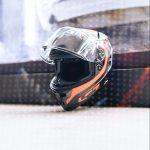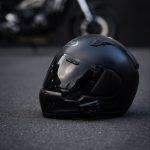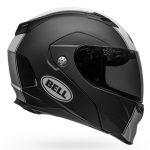Motorcycle helmet size chart : fitting and dimensions for safe riding
A good-fitting motorcycle helmet is essential to the performance of a helmet during an impact. It will literally save lives. Perfect protection is guaranteed when the helmet fits properly with the chin strap securely fastened and provides adequate peripheral vision. Learn all about it in the below Motorcycle Helmet size chart and sizing guide.
Looking for the perfect fit in motorcycle jackets? Check the moto jacket size chart here
Motorcycle Helmet Size chart
Adult Helmet sizing in cm, inches and hat size
| Motorcycle Helmet Sizing Chart | Head circumference | ||
| Adult Size | CM | Hat Size | Inches |
| XXSmall | 51-52 | 6 3/8 – 6 1/2 | 20 – 20.5 |
| XSmall | 53-54 | 6 5/8 – 6 3/4 | 20.87 – 21.26 |
| Small | 55-56 | 6 7/8 – 7 | 21.65 – 22.05 |
| Medium | 57-58 | 7 1/8 – 7 1/4 | 22.44 -22.83 |
| Large | 59-60 | 7 3/8 – 7 1/2 | 23.23 – 23.62 |
| XLarge | 61-62 | 7 5/8 – 7 3/4 | 24.02 – 24.41 |
| 2XLarge | 63-64 | 7 7/8 – 8 | 24.80 – 25.20 |
| 3XLarge | 65-66 | 8 1/8 – 8 1/4 | 25.60 – 26.00 |
| 4XLarge | 67-68 | 8 3/8 – 8 1/2 | 26.40 – 26.80 |
| 5XLarge | 69-70 | 8 5/8 – 8 3/4 | 27 – 27.50 |
Kid’s Motorcycle Helmet sizing in cm, inches and hat size
| Youth Helmet Sizing Chart | ||
| Youth Size | CM | Inches |
| Small | 49 – 50 | 19.15 – 19.50 |
| Medium | 51 – 52 | 20.10 – 20.45 |
| Large | 53 -54 | 20.87 – 21.26 |
How to choose your Motorcycle helmet size
How do I know my Motorcycle helmet size?
Step 1: Measure your head
Use a measuring tape to measure around your head one inch above your eyebrows. Or use a string to measure and then lay it out and measure the length of the string. Take several measurements to make sure you have the largest one.
Step 2: Choose your size
If your measurement is in between sizes, round up to the next largest one. If you use a balaclava or head sock, always measure and fit the helmet with it on. Use the chart to convert the measurement to your helmet size.
Step 3: Try on your Helmet
Fit the helmet model you would like to purchase. The helmet should have a snug-but-comfortable fit. When the helmet slides down on the head with no resistance, the helmet may be too large. When it doesn’t slide down over the head at all it is too small. When you feel some resistance at first, you might be reluctant to pull down, however, if it is just snug when pulling down, continue to pull the helmet on.
Most people will select a too-large helmet if left to make their own choice. A snug-fitting helmet is what you need. Helmets that are too large may not function as intended and in extreme cases may come off during an accident.
Step 4: Fit your motorcycle helmet
A helmet that feels snug:
- should be worn low on the brow
- Your eyes must be near the center of the eye opening
- The helmet touches the top of the head with firm pressure all around – tight pressure points.
Step 5: Buckle the Chin Strap
This strap should hold the helmet in place without discomfort, make sure the chin strap is snug against the throat.
What Are The Types Of Motorcycle Helmets ?
There are many words used to describe motorcycle helmets, but we will keep it simple. Based on primary design and safety ratings, there are six types of motorcycle helmets. Many of these designs can have one additional safety feature or another.
1. Full-face helmet
These are the only helmets that provide protection for the chin. They provide the most coverage for head and neck and are excellent for ALL types of riding. These are the best helmets with additional safety features. They are dual-certified helmets are the only helmet worn by speed racers.
2. Modular helmet
These helmets are full face helmets in which the entire chin bar and visor can flip up to expose at least one-quarter of the face. They are heavier than full face helmets and are excellent only in upright riding positions. This makes them an excellent choice for touring and cruising bikes.
3. Open Face Helmet
These helmets are also known as “open-face” because they cover your head, sides, back, but leave your entire face and chin exposed and provide limited sun protection. They have some of the best chin straps and are excellent for scooters, especially when supported with riding googles.
4. Half Helmets
These helmets cover the head from just above the eyebrows all the way to the neck and ears. They leave the rest of the face exposed and sometimes have small visors attached. These helmets provide the best airflow for the rider and for this reason there are many of them that passed Consumer Product Safety Commision safety standards and are still on the DOT-Only approved helmet.
5. Dirt Helmets
These helmets are the rugged sibling in the family. They are designed with maximum protection, minimum weight, and smoothest air flow to cope with excess pressure. They are expected to be used with goggles so they have wide visors. As they name suggests, they are excellent for off road biking. Always perform figment checks before purchases these type of helmets.
6. Dual-Sport Helmets
These helmets are the children of the union between the off road and the full face helmets. They are full face helmets that have been designed to go rough with solid chin bands. These helmets are excellent for mix terrain riding and their safety ratings are high. When you need more airflow, slide up the visor. When you need more protection, snap it shut.
Can I Use Other Helmets For Motorcycles ?
No, you can’t. The user weight greatly decides the correct motorcycle helmet. The correct helmet is an important piece of motorcycle gear. Always refer to the motorcycle helmet size chart from time to time and make adjustments to your size accordingly.
Conclusion
An appealing ride is better enjoyed under excellent riding conditions. Now that you know how to measure your helmet size, please do so. Then walk into the nearest store and pick up the type of helmet that fits both your journey and your head. Remember, safety first.
Leave a comment below and let us know what you think. Share this article with your friends as you all prepare for that ride.
Picture in this motorcycle helmet sizing post by Jusdevoyage on Unsplash








